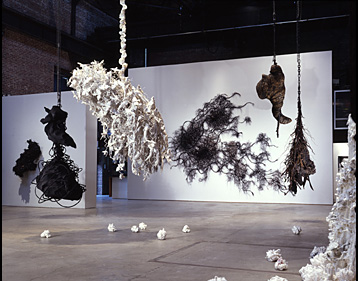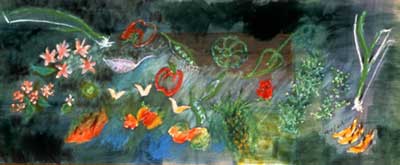
Dog-Patch Aesthetics vs. The Real Thing
Petah Coyne at Galerie Lelong; Loren MacIver at Alexandre Gallery; Henri Plaat and Vincent Hamel at Howard Scott
by Maureen Mullarkey
Petah Coyne was better when she was playing Pin-the-Tail-on-the-Virgin-Mary. It was a child’s game but fun to play for women who grew up when the Virgin was a cudgel for subduing high spirits and Catholic school girls were exhorted to be Marylike in all things. For a brief time I thought that Ms. Coyne’s Lady pieces were a send-up of religious kitsch. But no; they were just a swizzle stick to stir up shallow responses to a one-dimensional target.
 |
| Installation at the Sculpture Center, photo by Wit McKay |
Her exhibition at Galerie Lelong makes plain that Ms. Coyne revels in kitsch. Hers is the genuine article: art industry kitsch. On view are over-sized tchotchkes dumbed up to sculpture by écrivains d’art practicing their specialty: the abuse of language.
Here, the concept of sculpture is mere parenthesis to a dog-patch aesthetic that cheerfully confuses defacement with decoration. Suspended from walls or ceiling are tacky, ornate loopy stunts smothered in black wax. Their entertainment value lies precisely in their distance from sculpture. Architectonics are discarded; issues of structural integrity or cohesion do not apply. The artist uses wax as a sauce, poured like sludge to meld tenuous parts together. Elmer’s glue with black pigment added would do just as well.
Viewers can have fun getting a handle on description. “Homeland” (2002-04) is a ceiling-to-floor mistletoe for the damned from the set of “Dragoula.” (Pick your own Transylvanian classic.) Cascading arrangements of waxed artificial roses, “Little Ed’s Daughter Margaret” (2003-04) and “Whirlwind” (1989), are prom decorations, the kind of thing that looks poetical in semi-darkness after sneaking a few party pills. “Three-Tiered Chandelier” brings to mind a medieval game pie and the old nursery rhyme “Sing a Song of Sixpence.” Here are four and twenty fake blackbirds, plus a few more, cobbled together with candles in layered circles, all gunked in black wax. Isn’t that a dainty dish to set before an artwriter?
Tenured art appreciators are the natural audience for this show. This is art that can’t be bothered. The work has its eye on higher things: monographs, catalog essays, statements of curatorial piety—products of the talkoisie. It’s a game in which art matters less than the discourse it generates. Subordinate to what is said about it, the art object becomes a pawn of art bureaucrats and the critical establishment. So, displaced and in exile, even sculpture can slouch into transience and disposability. Commentary, on the other hand, endures forever in an archive near you.
With no brake on confounding the verbal with the visual, baroque utterance makes a donkey of the audience. Hence, Ms. Coyne’s parodies of sculptural intent are solemnified by eloquent essays in the accompanying catalogue. It is a dispiriting sport that suggests something desolate and synthetic at the heart of art world culture.
“Petah Coyne: Above and Beneath the Skin” at Galerie Lelong (528 West 26th Street, 212-315-0470).




Loren MacIver (1909-1998) had a formidable career as a painter in spite of herself. Largely untutored, she began painting simply for her own pleasure: “I cannot tell you how casual it was. I just like to paint.” But she did it so seductively that she was only 30 when Pierre Matisse—dealer for Balthus, Chagall, Giacometti—took on her work, representing her for 50 years until his death in 1989. She was honored with a Whitney retrospective in 1953, followed by major exhibitions at the Phillips Collection and the Musee d’Art Moderne, Paris. The first woman represented in MoMA’s permanent collection, she represented the America Pavilion in the 1962 Venice Biennale.
 |
| Garden (1987) |
Fashions change and reputations go into eclipse. Although MacIver’s art is unmistakably modern, it belongs to no school, illustrates no isms. It is an anomaly to curators who think in terms of movements and influences. While Alfred Barr began purchasing her work in1935, MoMA has not been generous in exhibiting it. “Hopscotch,” an inspired skip across the graphic pattern of a children’s sidewalk game, has been visible from time to time but little else. This show at Alexandre is a welcome opportunity to become better acquainted with a luminous painter outpaced by Pop and later trends.
MacIver’s preoccupations and expressive procedures are sunny and personal, unself-conscious in the best sense. “New York Sunset” (1981) captures a dazzling streak of cadmium yellows melting into pinks and fuschias over hazy roof tops. The blaze cascades down the crevice between two buildings, scattering like sparks over darkened roofs below that bear no perspectival relation to those above. The panorama anchors the composition and, joined by schematic suggestions of architecture on either side, frames the burst of concentrated light that is the composition’s raison d’etre.
“Green Votive Lights” (1980) is MacIver at her liveliest. A votive rack supplies the underlying grid for an all-over composition with no aggressive points of focus, no sharply delineated objects. The painting is a structured weave of glowing tints against a darkling ground, with overlays of one delicate stroke over another. Light finds its way in and out between the glass candle cups, flashing red, yellows and pale greens to indicate reflections and radiant heat. The rendering of light, vibrant and distilled, was MacIver’s essential subject.
“Loren MacIver: Selected Works” at Alexandre Gallery (41 East 57th Street, 212-755-2828).




Lovers of quietude and understated complexity will be thoroughly satisfied by this exhibition of abstractions by two Amsterdam artists born in the 1930s, Vincent Hamel and Henri Plaat. Both work on paper on an intimate scale that draws you within whispering distance; both are fastidious, cerebral and attracted to the excitement of subtleties. Beyond that, they could not be more different, though the distinctions between them are complementary and felicitous.
Mr. Hamel’s art is austere, almost monotone. You must stand close to see into and beyond stylishly minimal compositions. Everything depends on his handling: an obsessive delicacy put to the service of fine lines that accumulate into color zones, sensitive surfaces that swell and retreat, and edges that carry the weight of their making.
By contrast, Mr. Plaat is a voluptuary but one who knows the value of constraints. His geometry is audacious and distinctive, dazzling asymmetries unified by muted tones and tenderly differentiated surfaces. What look like paintings are actually collages; each severe shape is painted in gouache, hard contours offset by sensual skins that push a dry medium to marbleized effects. Delicious depths are created by an underlying color, sometimes two, breaking through the dominant one.
This is a show I intend to see again. Mr. Plaat, in particular, is one of the most alluring sensibilities I have encountered this season.
“Duet: Two Artists in Amsterdam” at Howard Scott Gallery ( 529 West 20th Street, 646-486-7004).




These reviews were
first published in The New York Sun, February 17, 2005.
Copyright 2005 Maureen Mullarkey







